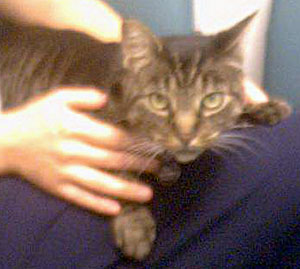|
Winter 2015
MEWS & NEWS
|
||
|
||
| February is Pet Dental Health Month
Eighty five percent of pets over the age of 4 years have some level of dental disease. This problem is often not addressed until there is significant disease with the need for extractions. Unless there is severe infection, most cats don’t let you know that their mouths are bothering them. We check our feline patient’s teeth at each regular exam visit and make recommendations when dental care is needed. During February we will be offering a complimentary bag of Prescription Diet t/d with every dental procedure performed so call and schedule today and mention this newsletter. If you don’t brush your kitty’s teeth a couple of times a week, we think that feeding t/d is the best preventive measure you can take to help keep teeth and gums healthy. t/d works best to prevent tartar buildup when it is started at a young age (before plaque builds) or after the teeth have been cleaned. Let us know if you have questions regarding your cat’s dental health. |

During February we are offering a complimentary bag of Prescription Diet t/d with every dental performed
|
|
|
||
| North American Diabetes Roundtable
In September, Dr. Wexler-Mitchell organized a roundtable involving 15 boarded feline specialists from the US and Canada to discuss the management of feline diabetes. It was a fabulous opportunity for those who treat diabetes every day to discuss what is and isn’t working. Dr. Wexler-Mitchell explains the roundtable: The best part of the roundtable was sharing our practical experiences and pooling data from our own clinics. We compiled almost 300 cases and performed statistical analysis to evaluate our findings. We felt that our private practice patients did not correlate to those seen at university referral institutions, and that we deal with more cases of diabetes than the internal medicine specialists at universities do. Diet was another thing that we discussed. Although we all do believe that feeding a low carbohydrate, high protein diet is best for diabetic cats, in actuality, most owners like to feed a variety of foods and most foods do not fall into this classification. When we looked at cats who had the longest survival with diabetes, they were not consistently eating low carbohydrate, high protein diets. They were not all eating canned food exclusively either. The most important conclusion we drew from our roundtable, is that diabetic regulation should be based on the individual cat’s quality of life and clinical signs. A cat with stable weight and fairly normal amounts of drinking and urination should be considered as a well regulated diabetic. His blood sugar values are secondary considerations. It should not be a goal to have the blood sugar at any specific value. Managing a feline diabetic is very challenging and there are cats that have secondary diseases that affect our ability to control their diabetes. We all felt that addressing dental disease and oral infections was important to diabetic regulation. Checking for other hormonal disorders such as Cushing’s disease and acromegaly and for pancreatitis needs to be considered if a diabetic patient is not doing well. Unfortunately we don’t know as much as we’d like about what goes on internally when a cat is diabetic. Insulin and a consistent diet are needed to best control the disease, but some cats actually survive for at least a short period of time with minimal care. We thought the studies from academia were giving us new hope for better control using Lantus insulin and obtaining diabetic remission, but the majority of cats need loose regulation of their blood sugar and more attention to their weights, water consumption, and urination. Veterinarian and owners need to rethink and focus on the diabetic cat’s quality of life and not just his blood sugar values. |
||
| The Cat Care Clinic Helps Kiki Get Back Home
On January 27, 2015 clients that had been feeding a friendly outdoor cat brought her in because of a skin rash. She had been hanging out in their yard for a few months. During her check in process which involved microchip scanning, we discovered a microchip. We searched out database and she matched with another clinic client. When contacted, “Kiki’s” owners reported that she had been missing for five months. We were able to happily reunite “Kiki” with them; all thanks to a simple microchip. The Cat Care Clinic recommends microchips for all of our patients. They really do work.  |
||
|
||
| Expert Loving Care… Just for Cats
The Cat Care Clinic |
||

 Is your cat stiff when she gets up from her naps? Is she going up the stairs a little slower or taking a couple of extra jumps to get up in her favorite perch? Your kitty may have arthritis. Unfortunately, there are not many good options for long-term treatment of arthritis in cats.
Is your cat stiff when she gets up from her naps? Is she going up the stairs a little slower or taking a couple of extra jumps to get up in her favorite perch? Your kitty may have arthritis. Unfortunately, there are not many good options for long-term treatment of arthritis in cats.




